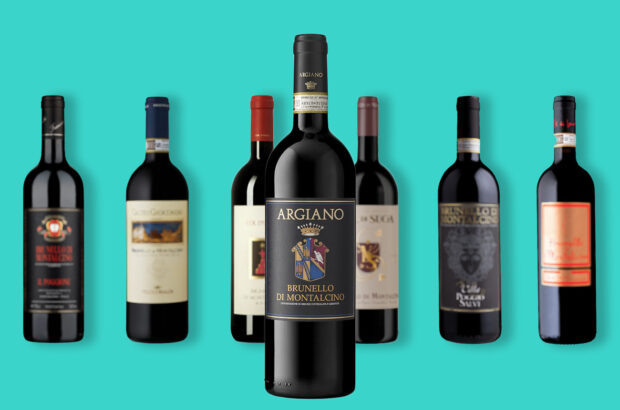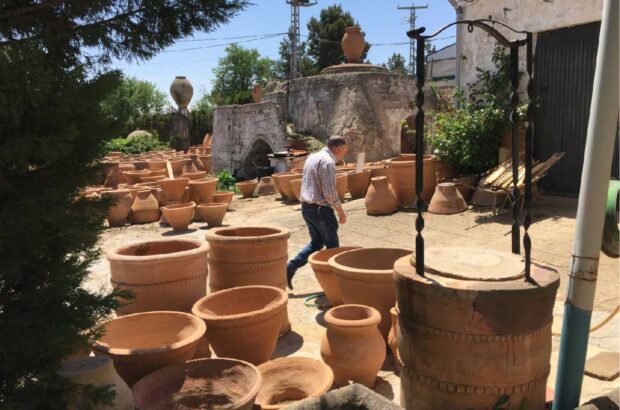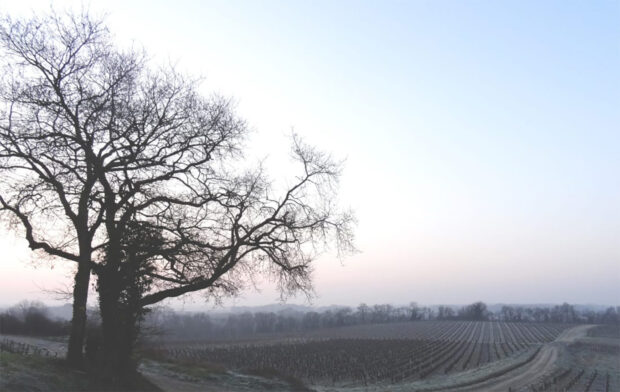- This wine fuels Air France’s first class passengers.
- Quality is pouring out of the region.
- Elegance but with their feet on terra firma.
- A range that speaks with a slight Australian accent.
Jacques Ribourel is showing me round his brand new Jacobus domain deep in the La Clape district of the Languedoc. It’s Spaghetti Western terrain, where the blasting heat of the Midi assembles to fry the land. Ribourel is beaming, in the manner not of the property tycoon he once was but of a kid suddenly confronted with the train set of his dreams. ‘Sixty-year old Cinsaut rootstock!’ he exults. ‘We’ve grafted on Syrah – so, next year we’ll have 60-year old Syrah!’ He’s uncharacteristically quiet about the other varieties he’s grafted – but not about the manifold natural advantages of the six-hectare (ha) site, or his aim. ‘Simple,’ he says. ‘To show that the Languedoc can make a truly great wine.’ Really? And at what sort of price? ‘A thousand francs a bottle, ex-cellar.’ Pardon me? ‘That will be around FF2,000 to the public. And we’re producing it as vin de table.’ Two thousand francs? Two hundred pounds? Three hundred dollars? For a bottle of Languedoc table wine? ‘You think the world’s ready for this?’ I ask. ‘The first harvest will be in 2001. Six thousand bottles will be available in 2003, and half of them are already allocated.’ Of course, Ribourel did not build two consecutive property fortunes by chance. He knows about promotion and marketing.
His main estate, l’Hospitalet, located near Narbonne, is without much doubt the best wine-based visitor centre in Southern France. The FF1,000 wine will, therefore, be dismissed as a crowd-pulling gimmick.The man himself couldn’t care less. More to the point, his wines have already established a solid quality reputation. They’re overseen by Michel Rolland and drunk at some of the best tables in Paris. His white Château l’Hospitalet fuels Air France’s first class passengers (not surprisingly: it’s a lovely, slightly oaked summer fruit blend of Bourboulenc, Roussanne and Rolle). And his domaine prices already range beyond FF80 (£8). Granted, it’s a bit of a leap from FF80 to FF1,000, but not completely in the dark. Again, set in the wider Languedoc context, the Jacobus project appears extreme, but not absurd. Quality is pouring out of the region. Its image as a zone of cheerful varietal wines and ACs of potential is out of date. That potential is being realised. High ambitions are absolutely legitimate.
For instance at Château Puech-Haut in Saint-Drézéry. Like Ribourel, Gérard Bru made his money outside wine and ploughed a significant slice into 26ha of vineless garrigue between Montpellier and the Pic Saint-Loup. He planted mainly Syrah, and then waited 15 years before producing a single bottle under his own label. This gave him time to identify a magnificent mansion due for demolition in the middle of Montpellier. He had it removed and rebuilt as the family home on the windy rise at the centre of his domaine. He created a splendid cave nearby, equipped with technical advice from Château Margaux, and called in Michel Rolland as consultant: the man gets everywhere. Puech-Haut amply justifies Bru’s claim that the Saint-Drézéry terroir should soon qualify for village status. The 1998 white sparkles with fruit, flowers and complexity. Of the two reds, the Prestige is the more readily accessible, while the Tête de Cuvée is a little tougher, but has a terrific expression of Syrah. Both are from the difficult 1997 harvest: impressive achievements indeed.
Vignerons & Passions, Saint-Félix-de-Lodez, has a rotten name (the word ‘passion’ crops up so often in French wine circles that it’s virtually meaningless), but is a great idea. Under the aegis of négociants Jeanjean, Bruno Peyre has brought together 31 of what he calls ‘la crème de la crème’ of Languedoc producers. Scattered across all the regional appellations, the producers work with Peyre to create cuvées sold under their own names but to top-end specifications. Recently, Peyre took me round his Costières de Nîmes partners and it proved a bit of an eye-opener. Last time I’d been near the place – long ago – I’d come back with a throat like a down spout. Now, however, Château Paul Blanc’s 1997 had an excellent balance of strength, structure and fruit, showing real character, while the Château de Bonice 1998 was gamier. Not far away, the Château de Valcombe basked in a sort of Côte-Rôtie North-South hillside exposition. Its most successful expression was the 1998 Château de Surville (different name, same property) whose balance of red fruit and more masculine tones made for a wine of great harmony. Of V&P’s other wines, the Domaine de Tudery (Saint-Chinian) and Château de l’Ille (Corbières) were among the most notable.
People in La Livinière spend a lot of time trying not to say they are ‘upper-class Minervois producers,’ but that’s effectively what they are; otherwise, the question of a separate appellation would never have arisen. And, my word, it’s being taken seriously. Already there are two quality levels within La Livinière itself: a first for wines that qualify for the special capsule and a second for those that don’t. The latter are fine, but the former are followed throughout their evolution by a special commission of fellow producers, and come with a written guarantee of quality from the AC syndicat.
The results are already impressive – the La Livinière cooperative’s Grand Terroir 1997 has a spicy, mineral depth – and will get more so, with help from the likes of Domaine Borie de Maurel, Château Maris and Château Massamier la Mignarde. Château de Pennautier, Cabardès, is a château worthy of the name, a 17th century scaled-down version of Versailles – and still owned by descendants of the original builders. Cabardès gained full AC status this year. Located north of Carcassonne and south of the Montagne Noire, it’s influenced by both Mediterranean and oceanic climates and is the only appellation allowed to mix both Bordeaux and Languedoc grape varieties. At Pennautier and its sister estate La Bastide, they do it splendidly. La Bastide’s range is a little earthier, Pennautier’s more Bordeaux in style – but, from each, there are wonderfully structured wines in which both influences combine to create something quite separate. They have a sort of elegance but with their feet on terra firma. Meanwhile, the Esprit de Pennautier cuvée – a blend of the year’s best Mediterranean and Bordeaux varieties – should not be missed.
Penval is the name under which Australian giant Southcorp works in France. The firm encompasses a mainly French team operating from tiny offices in Narbonne who have scoured the Languedoc for top-class producers with whom to cooperate. ‘We wanted the best terroirs and a maximum of Syrah,’ says Penval boss, Bernard Schurr. ‘We found them in the appellation zones.’ The result is a range that speaks of Languedoc with the slightest of Australian accents – tannins rounded out through micro-oxygenation, that kind of thing. Look out for the Costières de Nîmes from Bazac, the Pic Saint-Loup selection and, from the Corbières, the Domaine des Courtilles 1998: rich, powerful and harmonious too.
At Domaine La Chevalière, Béziers, Yves Barry is among the many who consider the Languedoc’s appellation regulations far too restrictive. He’s knocked around the New World and is impatient of ’emmerdements’. Thus, when appointed boss of Michel Laroche’s incursion from Chablis to the Midi, he took the vin de pays route. Note, however, that these are not any old vins de pays. The vins de pays sector is now hierarchised alongside (not below) the appellation one. It has a similar concern for different terroirs, and the Chevalière range is among the most interesting that has recently crossed my palate. Consider, for instance, an old-vine, single-variety Terret, sharp, lively and, of course, all-but-unsaleable to English folk, who don’t eat much shellfish. The Terret-Chardonnay blend is more the British style, and a beauty.Among the reds, the Merlot-Grenache blend works splendidly. Indeed, there’s barely a weak link among the 16 wines, and, at the top, the Grande Reserve blanc (Chardonnay, Marsanne, Viognier) and rouge (Merlot, Cabernet Sauvignon, Syrah) are items of real breeding.
When Robert Skalli, pioneer of Languedoc varietals, turned his hand to appellation wines last year at Sète, the regional wine world expressed astonishment. The move seemed logical to me. For all his championship of international varietals, Skalli had long sought to root them in Mediterranean surroundings. The AC initiative was a simple extension of just that. The company knew Languedoc people, grapes and, crucially, terroirs better than most. It made sense to exploit the knowledge further – and extend the Skalli range. The results are ACs from the three biggest Languedoc regions, of which the Corbières 1998 is the most successful. Deep, round, full of sun and minerals, it expresses the Skalli Mediterranean approach vividly. The Côteaux du Languedoc and Minervois, while a little less concentrated, fully warrant your attention at around a fiver a bottle. Skalli continues to pursue his original course with a new, mid-range trio of varietals under the name Séléction. At about £6, they are evidence of a winemaking team entirely on top of the job. And, if you want Skalli’s best, there’s the ‘Réserve F’ range – whose Chardonnay is quite outstanding. In Languedoc, as we speak, there’s treasure everywhere.











